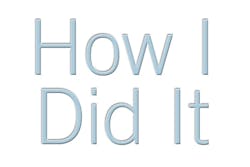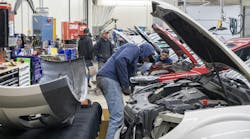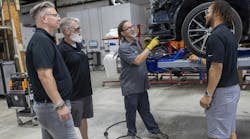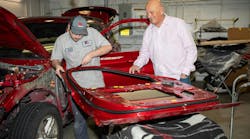Collision Leaders Share Their Secrets to Success
Alysia Hanks tells how at 31, she’s gone from the office manager at a collision shop to founding—and now running—a trade association aimed at helping repairers in Louisiana even the playing field with insurers.
I just remember looking around and wondering why no one was doing anything. There are a lot of shops in Louisiana, there are a lot of industry professionals all around our state, but we were all isolated.
No one spoke. No one worked together toward common goals. We were all on our own little islands. I’d see other associations and organizations around the country, and it just made no sense to me: Why is everyone just willing to sit back and not do anything?
That’s where the idea for the Louisiana Collision Industry Association came about.
And I’m not some industry expert. I’m not a shop owner. I’ve worked at Lakeway Collision in Mandeville for eight years—my whole career—and I’ll be the first to say I don’t know everything about this industry, and I never expected myself to be in this position today. But here I am.
The idea first came to me several years ago. We were struggling in Louisiana to have any legs to stand on against insurance companies. Because we were all isolated from one another, no one was aware of market value on things, no one really knew what was going on with anyone else. We had to take what the insurers told us as fact.
I’m the office manager at Lakeway. I dealt with these issues every day. And then, when State Farm began to push its Parts Trader program in our state last year, things really hit a breaking point.
It all started by me just contacting other shops in our area to see if they’d want to take part in a local meeting. There were a few that said they would, so I booked a conference room. Then word started to spread, and more and more shops from farther and farther out wanted to be a part of this.
We had a few hundred attendees at that first interest meeting, and we made the move to push forward and create an official association. I worked with lawyers and sought advice from other trade organizations—the Louisiana Automobile Dealers Association being one of them. My father-in-law is a member of the dealer association, and he was a huge help to me.
We formed a board of directors and we’ve had four official meetings since. We now have more than 70 members and 400 or so people on our mailing list.
But to be clear, we didn’t start this organization for lawsuits against insurers—or even just to rail against them. This is about uniting the industry in this area, getting information out to them and trying to help everyone be as successful as possible.
Steve and Holly Copeland
Co-owners | Copeland Auto Body
Steve shares how he and wife Holly used brand awareness to grow a once 2,000-square-foot shop into a $1 million business in a town of 756 people.
The thing about being in a small town is that it’s very hard to develop trust with a customer, but once you have it, you have it for life.
I know that every shop isn’t in our situation, and I know a lot of what other shops do doesn’t necessarily relate back to us, either. The key for me has always been to look at what other successful shops do and take the concepts, the ideas and bring it back to my business and apply it in a way that works for us.
That’s where the idea of brand awareness comes in; it’s a common marketing term that people throw around a lot these days, but when I hear seminars on it or other shop owners talk about it, I think back to that first point: It’s all about building trust.
We are that brand—my shop, my team, myself. And for us, brand awareness has always been about the way we represent ourselves to our customers and in our community. It’s how we build that trust, how we enhance the repair experience, and how that helps us build business.
This shop started in a 40 feet by 50 feet building in 1994, and we just grew through word of mouth.
I’ve worked with 20 Groups, I’ve had consultants and coaches, I’ve looked for management training wherever I could find it. By focusing on operations—implementing standard operating procedures, using repeatable systems, managing workflow, monitoring the numbers—we became efficient with our space. We really learned how to use it.
We were doing about $50,000 per month in sales in 2008 and we had a huge backlog of work. So, we expanded the facility to 6,500 square feet. We put in a nicer, larger waiting area, and set the shop up with a lean mindset.
We added staff and, even though our volume increased, our efficiency allowed us to spend more time with each customer.
Time is the key here—that’s what customer service is all about. We take the time to hear the customer’s issues. We do a thorough check-in process, and we’ll walk the customer through the repair process and give them a tour of the shop. We make sure every customer is updated on their vehicles. We make sure the repairs are done on time.
We did $1.2 million in total sales in 2013. That’s a big climb in just several years, and there were a lot of factors. But, bottom line, people trust us. Our closing rate is above 90 percent on all estimates, and our CSI scores are always in the upper 90s.
Being in a rural area, we have to pull from other areas to get customers. We have to give them a reason to drive to us, over driving somewhere else.
Joe Amodei
Owner | The Collision Centers
Joe Amodei explains how he created a consistent, stable business model that allowed him to scale the company into Long Island’s leading MSO.
A lot of shops will grow before they really understand how to scale their company. They’ll grow due to opportunity, but rarely have a plan.
I know, because that’s what we did—at least in the beginning.
We’re now in our 25th year at our original location in Patchogue on Long Island. We opened our second shop in Riverhead in 2007; our third location in Babylon opened in 2012.
Both of those additional locations came out of necessity and opportunities that presented themselves. We had insurers come to us and say they were looking for a partner shop in those areas—if only we were there. We did the research on the markets and the locations that were available, and we made the moves.
It all hit a point where we simply couldn’t go on working that way. In 2013, I had a conversation with industry consultant Mike Anderson, and he talked to me about how opening a third location can be the hardest thing you do. No longer can you operate with a single-shop mindset.And they worked, sort of. We were successful, we were making money. But it was total chaos. My two sons are in the company as managers, and Joe Musetti, who’s been with me for 19 years, is our general manager. We were all running around back and forth between the shops trying to make it work.
We had to build a consistent company across the board that could produce consistent results. Doesn’t sound very easy, does it?
It started with rebranding, and focusing on what customers see. Our original shop was called 112 Automotive, because it was on Route 112. That doesn’t work when your next location is clear across town nowhere near that road. We transitioned our branding to the name “The Collision Centers,” with each location being “The Collision Center at Babylon,” or “at Riverhead,” or “at Patchogue.”
Then, we set up a direct chain of command in each shop: Each estimator had specific techs, painters and detailers, and the vehicle that went to that estimator would flow through his team.After that, we focused on creating a streamlined, standardized repair process, so that the results would be as consistent as the brand. Customers could know what to expect. We put in SOPs for everything, but we also overhauled the way things were done. We started doing 100 percent teardowns and blueprinting on every repair.
That helped our managers—my two sons and Joe—stay in a real managerial role, each overseeing a facility. Suddenly, workflow was precise, and our shops became more efficient.
Our labor gross profit margin went from 40–45 percent to upwards of 68 percent. Sales were just below $10 million at the three shops in 2013. We’re on pace in 2014 to do above $13 million.
We’re opening a fourth shop, and the goal is for at least two more in the coming years. We’re still growing, and we’re going to grow the right way with a plan.
General manager, The Collision Centers
The processes we put in place really help all the shops run smoothly. We have a great process. Our team is on commission-based pay, and with the SOPs in place and the workflow process, you don’t need to crack the whip as a manager. The guys do that on their own; they really self-police now.
Mike and Rhonda Terrell
Co-Owner | Darrell Allen Body Shop
Mike Terrell shares how he and wife Rhonda overhauled their operations to create a team-based workflow that chopped cycle time by 2.3 days and increased revenue by nearly 20 percent.
We had to look at our goals differently. It can’t be simply about making more money. Adding revenue or cars doesn’t necessarily improve margins or profitability. Sometimes it hurts.
About two years ago, my wife, Rhonda, and I changed that mindset: We wanted our shop to make money more efficiently.
We had a big backlog of cars. People were waiting two months on drivable repairs. It’s a good problem to have, but we were missing out on all those jobs. Adding on to our building or hiring more people meant we could get those cars through, but would we actually make more money in terms of profit? Not really.
We went to management training, worked with a coach—all these different things, and we realized that if we were going to grow, we simply had to change.
And we had to change everything.
We have a 40,500-square-foot shop and 40 employees. We’re a part of 15 direct repair programs, and we’re a certified shop for Nissan, Toyota, Honda, and GM, and we’re a part of Ford’s new network.
We’re a big operation that has always invested heavily in our building, equipment and people. So, we had everything here, in this building, to be as effective as possible. But we weren’t getting it done. Our shop really focuses on big hits; we do pretty much all the big hits in our area. So, our cycle time was above 13 days and our car count was barely above 200.
To improve, we overhauled our repair process and went to a team-based system.
We split our shop into two teams of employees—two simply because of the size of our staff and our facility; we had the right amount of space to split it like that.
Each team would handle specific jobs and work together to pull the vehicle through the shop, from department to department. We have 12 bodymen total, so we put six on each team. We have five painters—two went to one team, three to the other. Each team also has either five or six “helpers” at various stages of the process. Each team has a designated customer service representative in the front.
Then, there’s one team leader for each team. They’re also the lead estimator, and do our blueprinting.
I want our most-experienced, most-skilled person—the team leader—doing the teardown and blueprint, because I want them to set the tone and standard for each repair. It helps them monitor it, too, as it goes through the shop. They’re aware of everything that goes on.
The team leader will do the teardown, blueprint the repair, and put all bad parts on a cart. We’ll get all parts ordered. Then, once they’re in, it moves to body, then prep, then paint. Then it goes back to build and to detailing and final inspections.
We have a precise flow, and each person works to do their jobs to push the team forward. We didn’t change our pay system. We didn’t feel we needed to. They are paid on commission, and as we became more efficient they were all making more money. So was the shop—and I mean actually making money, not just increasing sales.
Cycle time dropped by nearly 2.5 days, we reduced our supplement ratio by 60 percent, and car count went up to roughly 250 per month.
Those were 2013 numbers, and we only implemented this in July of last year.
We did $5.8 million in 2013, but we hit $684,000 in January this year. We’re looking to go well above $7 million for 2014. And that’s with the same team, same facility and same people in charge. Our goals are just different now.




